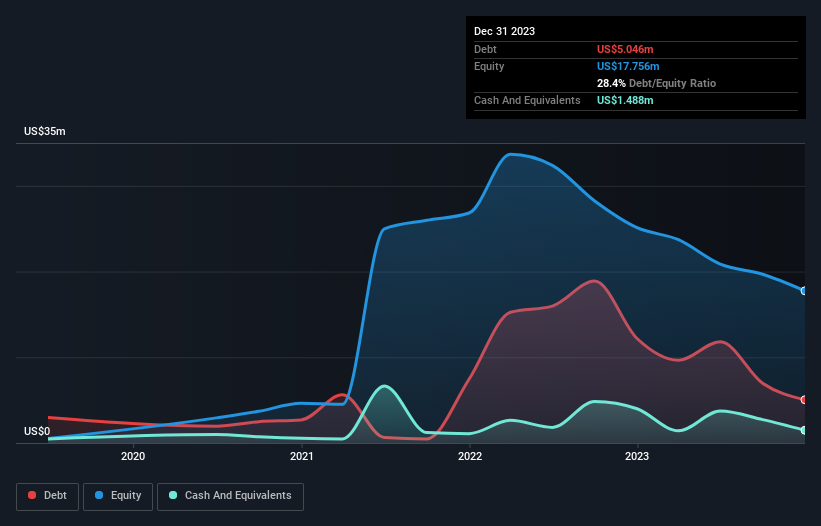- United States
- /
- Trade Distributors
- /
- NasdaqCM:IPW
Health Check: How Prudently Does iPower (NASDAQ:IPW) Use Debt?

Some say volatility, rather than debt, is the best way to think about risk as an investor, but Warren Buffett famously said that 'Volatility is far from synonymous with risk.' So it might be obvious that you need to consider debt, when you think about how risky any given stock is, because too much debt can sink a company. We note that iPower Inc. (NASDAQ:IPW) does have debt on its balance sheet. But the real question is whether this debt is making the company risky.
When Is Debt Dangerous?
Debt is a tool to help businesses grow, but if a business is incapable of paying off its lenders, then it exists at their mercy. If things get really bad, the lenders can take control of the business. However, a more frequent (but still costly) occurrence is where a company must issue shares at bargain-basement prices, permanently diluting shareholders, just to shore up its balance sheet. By replacing dilution, though, debt can be an extremely good tool for businesses that need capital to invest in growth at high rates of return. When we examine debt levels, we first consider both cash and debt levels, together.
View our latest analysis for iPower
What Is iPower's Net Debt?
You can click the graphic below for the historical numbers, but it shows that iPower had US$5.05m of debt in December 2023, down from US$12.2m, one year before. However, it does have US$1.49m in cash offsetting this, leading to net debt of about US$3.56m.

How Healthy Is iPower's Balance Sheet?
According to the last reported balance sheet, iPower had liabilities of US$25.8m due within 12 months, and liabilities of US$5.50m due beyond 12 months. On the other hand, it had cash of US$1.49m and US$11.8m worth of receivables due within a year. So its liabilities outweigh the sum of its cash and (near-term) receivables by US$18.0m.
This deficit casts a shadow over the US$11.9m company, like a colossus towering over mere mortals. So we definitely think shareholders need to watch this one closely. At the end of the day, iPower would probably need a major re-capitalization if its creditors were to demand repayment. When analysing debt levels, the balance sheet is the obvious place to start. But it is future earnings, more than anything, that will determine iPower's ability to maintain a healthy balance sheet going forward. So if you're focused on the future you can check out this free report showing analyst profit forecasts.
Over 12 months, iPower made a loss at the EBIT level, and saw its revenue drop to US$87m, which is a fall of 3.6%. We would much prefer see growth.
Caveat Emptor
Over the last twelve months iPower produced an earnings before interest and tax (EBIT) loss. Indeed, it lost a very considerable US$8.6m at the EBIT level. When we look at that alongside the significant liabilities, we're not particularly confident about the company. We'd want to see some strong near-term improvements before getting too interested in the stock. It's fair to say the loss of US$7.7m didn't encourage us either; we'd like to see a profit. And until that time we think this is a risky stock. The balance sheet is clearly the area to focus on when you are analysing debt. However, not all investment risk resides within the balance sheet - far from it. We've identified 3 warning signs with iPower , and understanding them should be part of your investment process.
If you're interested in investing in businesses that can grow profits without the burden of debt, then check out this free list of growing businesses that have net cash on the balance sheet.
Valuation is complex, but we're here to simplify it.
Discover if iPower might be undervalued or overvalued with our detailed analysis, featuring fair value estimates, potential risks, dividends, insider trades, and its financial condition.
Access Free AnalysisHave feedback on this article? Concerned about the content? Get in touch with us directly. Alternatively, email editorial-team (at) simplywallst.com.
This article by Simply Wall St is general in nature. We provide commentary based on historical data and analyst forecasts only using an unbiased methodology and our articles are not intended to be financial advice. It does not constitute a recommendation to buy or sell any stock, and does not take account of your objectives, or your financial situation. We aim to bring you long-term focused analysis driven by fundamental data. Note that our analysis may not factor in the latest price-sensitive company announcements or qualitative material. Simply Wall St has no position in any stocks mentioned.
About NasdaqCM:IPW
iPower
Operates as an online retailer and supplier of consumer home, pet, garden, outdoor, and consumer electronics products for commercial and home cultivators growing specialty crops, and home goods customers in the United States.
Excellent balance sheet low.
Market Insights
Community Narratives




